
Brodiaea, also known by the common name cluster-lilies, is a monocot genus of flowering plants.
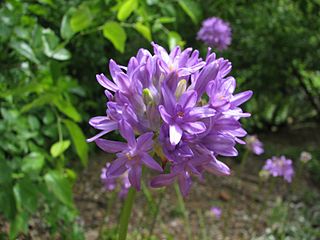
Dichelostemma multiflorum is a species of flowering plant known by the common names round-tooth snake-lily, many-flower brodiaea and wild hyacinth. It is native to California and Oregon, where it grows in hills, mountains, and inland grasslands. It is a perennial wildflower erecting a tall, naked stem topped with a spherical inflorescence of up to 35 densely packed purple or pink-purple flowers. Each flower is a tube about a centimeter long with six petal-like lobes arranged in a starlike corolla. The lobes may curl back slightly.
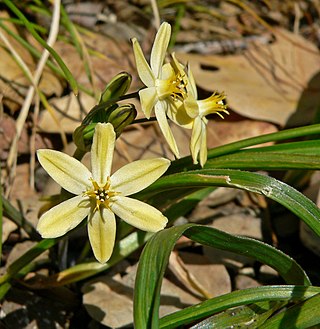
Triteleia ixioides, known as prettyface or golden star, is a monocotyledon flowering plant in the genus Triteleia. It is native to northern and central California and southwestern Oregon, where it can be found in coastal and inland coniferous forests and other habitat. It is a perennial wildflower growing from a corm. It produces one to two basal leaves up to 50 centimeters long by 1.5 wide. The inflorescence arises on an erect stem up to 80 centimeters tall. It is an umbel-like cluster of several flowers each borne on a pedicel up to 7 centimeters long. The flowers are variable in size, measuring one to nearly three centimeters in length. They are pale to bright yellow, or sometimes purple-tinged white. There are six tepals with darker midveins in shades of green, brown, or purple. The lobes are funnel-shaped and may open flat or somewhat reflexed. The six stamens form a fused tube that protrudes from the corolla; they have broad, flat filaments and whitish, yellowish, or blue anthers.

Hooveria purpurea is a species of flowering plant related to the agaves known by the common name purple amole. This species of soap plant is endemic to California, where it grows in the Santa Lucia Range, in the Central Coast region. There are two varieties of this plant, and both are believed to be quite rare. It is a federally listed threatened species.

Erythronium helenae is a species of flowering plant in the lily family which is known by the common names Pacific fawn lily and St. Helena fawn lily. It is endemic to the coastal mountains north of the San Francisco Bay Area in California. It is named for the local peak Mount Saint Helena, forming the point where Napa, Sonoma and Lake Counties meet. It grows on the slopes of the mountain at elevations of 500–1200 m, often on serpentine soils.
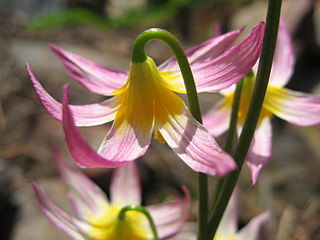
Erythronium purpurascens is a species of flowering plant in the lily family which is known by the common names purple fawn lily and Sierra Nevada fawn lily.

Brodiaea coronaria is the type species of Brodiaea and also known by the common names harvest brodiaea and crown brodiaea. It is native to western North America from British Columbia to northern California, where it grows in mountains and grasslands.

Brodiaea filifolia, known by the common name threadleaf brodiaea, is a rare species of flowering plant in the cluster-lily genus. It is endemic to southern California, mostly in the region around the junction of Orange, Riverside, and San Diego Counties.
Brodiaea insignis is a rare species of flowering plant in the cluster-lily genus known by the common name Kaweah brodiaea. It is endemic to the Sierra Nevada foothills of central Tulare County, California, where it grows along the Tule and Kaweah Rivers. It is considered endangered on the state level.
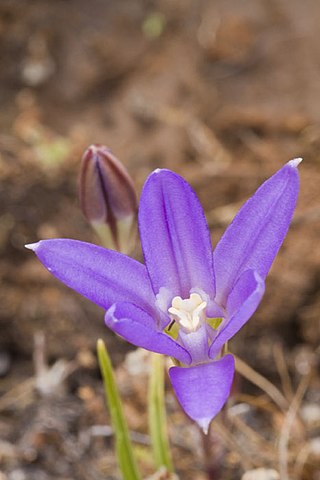
Brodiaea jolonensis, known by the common name chaparral brodiaea, is a species of flowering plant in the cluster-lily family.
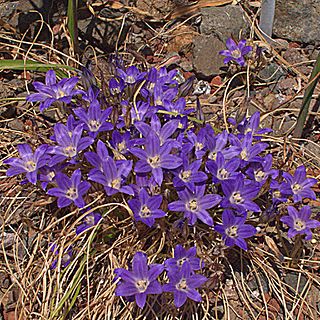
Brodiaea minor is a species of flowering plant in the cluster-lily genus known by the common names dwarf brodiaea and vernalpool brodiaea.
Brodiaea orcuttii is a species of flowering plant in the family Asparagaceae, subfamily Brodiaeoideae. It is a cluster-lily known by the common name Orcutt's brodiaea. The bulb is native to Southern California, mainly San Diego County, where it is an uncommon species. Its range probably extends into Baja California.

Brodiaea pallida is a rare species of flowering plant in the cluster-lily genus known by the common name Chinese Camp brodiaea.
Brodiaea stellaris is a species of flowering plant in the cluster-lily genus known by the common name starflower brodiaea.

Calochortus elegans is a species of flowering plant in the lily family known by the common name elegant Mariposa lily, cat's ear, elegant cat's ears or star tulip. It is native to the western United States from northern California to Montana.
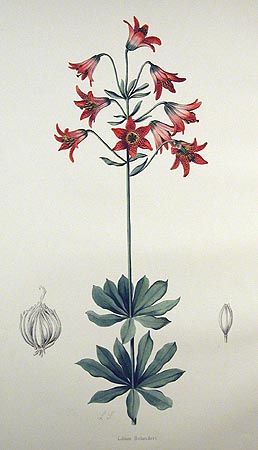
Lilium bolanderi is a rare North American species of plants in the lily family, known by the common name Bolander's lily. It is native to northwestern California and southwestern Oregon.

Lilium rubescens is an uncommon species of lily known by the common names redwood lily and chaparral lily. It is native to northwestern California and southwestern Oregon, where it is known from the Coast Ranges from Lane County to Santa Cruz Counties.

Triteleia dudleyi is a species of flowering plant known by the common name Dudley's triteleia. It is endemic to California, where it is known from sections of the High Sierra Nevada and the Transverse Ranges. It is a plant of subalpine climates, growing in mountain forests. It is a perennial herb growing from a corm. It produces two or three basal leaves up to 30 centimeters long by one wide. The inflorescence arises on an erect stem up to 30 or 35 centimeters tall and bears an umbel-like cluster of many flowers. Each flower is a funnel-shaped yellow bloom that dries purple. The flower has six lobes measuring up to 1.2 centimeters long. There are six stamens with lavender anthers.

Triteleia hyacinthina is a species of flowering plant known by the common names white brodiaea, white tripletlily, hyacinth brodiaea, and fool's onion. It is native to western North America from British Columbia to Idaho to central California. Its habitat includes grassland and vernally moist areas such as meadows and vernal pools. It is a perennial herb growing from a corm. It produces two or three basal leaves up to 40 centimeters (16 in) long by 2 centimeters (0.79 in) wide. The inflorescence arises on an erect stem up to 60 centimeters (24 in) tall and bears an umbel-like cluster of many flowers. Each flower is a funnel-shaped bloom borne on a pedicel up to 5 centimeters (2.0 in) long. The flower is white, often tinged purple along the tubular throat, with six green-veined tepals. There are six stamens with white, yellow, or occasionally blue anthers.
Erythronium elegans is a rare species of flowering plant in the lily family known by the common names Coast Range fawnlily and elegant fawnlily. It is endemic to Oregon in the United States, where it is known from about 12 occurrences in the northern Coast Range.
















